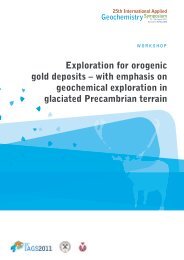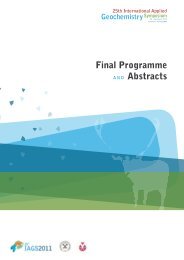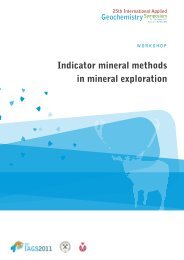Active and ongoing gold exploration and mining in ... - IAGS 2011
Active and ongoing gold exploration and mining in ... - IAGS 2011
Active and ongoing gold exploration and mining in ... - IAGS 2011
You also want an ePaper? Increase the reach of your titles
YUMPU automatically turns print PDFs into web optimized ePapers that Google loves.
ocks <strong>in</strong> northernmost Sweden <strong>in</strong>to low-, medium-<br />
<strong>and</strong> high-grade areas. It is <strong>in</strong>terest<strong>in</strong>g to note<br />
that most of the low-grade areas there (i.e. Kiruna,<br />
Rensjön <strong>and</strong> Stora Sjöfallet) are located <strong>in</strong> the westernmost<br />
part of Norrbotten whereas the majority of<br />
medium to high grade metamorphic rocks are located<br />
<strong>in</strong> the central to eastern part where also the vast<br />
majority of the L<strong>in</strong>a type granites (1.81–1.78 Ga)<br />
are situated. The strong spatial relationship between<br />
the higher-grade metamorphic rocks <strong>and</strong> the S-type<br />
granites is either a result of deeper erosional level of<br />
the crust <strong>in</strong> these areas or reflects areas affected by<br />
higher heat flow at c. 1.8 Ga.<br />
In central F<strong>in</strong>nish Lapl<strong>and</strong>, the follow<strong>in</strong>g<br />
metamorphic zones have been mapped (Hölttä et al.<br />
2007): I) granulite facies migmatitic amphibolites<br />
south of the Lapl<strong>and</strong> Granulite Belt, II) high pressure<br />
mid-amphibolite facies rocks south of the zone<br />
I, characterised by garnet-kyanite-biotite-muscovite<br />
assemblages with local migmatisation <strong>in</strong> metapelites,<br />
<strong>and</strong> garnet-hornblende-plagioclase assemblages <strong>in</strong><br />
mafic rocks, III) low-pressure mid-amphibolite facies<br />
rocks south of the zone II, with garnet-<strong>and</strong>alusite-staurolite-chlorite-muscovite<br />
assemblages with<br />
retrograde chloritoid <strong>and</strong> kyanite <strong>in</strong> metapelites,<br />
<strong>and</strong> hornblende-plagioclase-quartz±garnet <strong>in</strong> metabasites,<br />
IV) greenschist facies rocks of the Central<br />
Epigenetic Au deposits <strong>in</strong> northern<br />
Fennosc<strong>and</strong>ian shield<br />
Pasi Eilu<br />
Geological Survey of F<strong>in</strong>l<strong>and</strong>, Espoo, F<strong>in</strong>l<strong>and</strong><br />
Olof Mart<strong>in</strong>sson<br />
Luleå University of Technology, Luleå, Sweden<br />
Epigenetic sulphide deposits <strong>in</strong> the northern part of<br />
the Fennosc<strong>and</strong>ian Shield have an extensive variation<br />
<strong>in</strong> the style of m<strong>in</strong>eralisation, alteration, metal<br />
association, <strong>and</strong> host rock. Most deposits occur <strong>in</strong><br />
(1) Palaeoproterozoic greenstones <strong>in</strong> the Central<br />
Lapl<strong>and</strong> <strong>and</strong> Kuusamo belts <strong>in</strong> F<strong>in</strong>l<strong>and</strong>, but also <strong>in</strong><br />
Sweden <strong>and</strong> Norway, <strong>and</strong> <strong>in</strong> (2) Svecofennian rocks<br />
of the Porphyrite <strong>and</strong> Kiirunavaara Groups <strong>in</strong> Sweden.<br />
Due to their variable <strong>and</strong> overlapp<strong>in</strong>g features<br />
(Table 1), several genetic types have been proposed<br />
for them (Ojala et al. 2007). Here, we only discuss<br />
deposit types detected <strong>in</strong> the area covered by the<br />
present field excursion (Table 1).<br />
Many parameters used to describe ore occurrences<br />
are identical when e.g. IOCG <strong>and</strong> orogenic<br />
<strong>gold</strong> m<strong>in</strong>eralisation is compared. For <strong>in</strong>stance,<br />
Lapl<strong>and</strong> Greenstone Belt, with f<strong>in</strong>e-gra<strong>in</strong>ed white<br />
mica-chlorite-biotite-albite-quartz <strong>in</strong> metapelites,<br />
<strong>and</strong> act<strong>in</strong>olite-albite-chlorite-epidote-carbonate <strong>in</strong><br />
metabasites, V) prograde metamorphism south of<br />
the zone IV from lower-amphibolite (<strong>and</strong>alusitekyanite-staurolite-muscovite-chlorite±chloritoid<br />
schists), to mid-amphibolite facies (kyanite-<strong>and</strong>alusite-staurolite-biotite-muscovite<br />
gneisses, <strong>and</strong> upper<br />
amphibolite facies garnet-sillimanite-biotite gneisses,<br />
VI) amphibolite facies pluton-derived metamorphism<br />
related with heat flow from central <strong>and</strong> western<br />
Lapl<strong>and</strong> granitoids.<br />
The present structural geometry shows an<br />
<strong>in</strong>verted gradient where pressure <strong>and</strong> temperature<br />
<strong>in</strong>crease upwards <strong>in</strong> the present tectonostratigraphy<br />
from greenschist facies <strong>in</strong> the zone IV through<br />
garnet-<strong>and</strong>alusite-staurolite grade <strong>in</strong> the zone III<br />
<strong>and</strong> garnet-kyanite grade amphibolite facies <strong>in</strong> the<br />
zone II to granulite facies <strong>in</strong> the zone I. The <strong>in</strong>verted<br />
gradient could be expla<strong>in</strong>ed by crustal thicken<strong>in</strong>g<br />
caused by overthrust of the hot granulite complex<br />
onto the lower grade rocks. Metamorphism <strong>in</strong> the<br />
Lapl<strong>and</strong> Granulite Belt occurred at 1.91–1.88 Ga<br />
(Tuisku & Huhma 2006), but the present metamorphic<br />
structure <strong>in</strong> central F<strong>in</strong>nish Lapl<strong>and</strong> may record<br />
later, postmetamorphic thrust<strong>in</strong>g <strong>and</strong> fold<strong>in</strong>g events<br />
(Hölttä et al. 2007).<br />
features of the orogenic <strong>gold</strong> occurrences observed<br />
<strong>in</strong> F<strong>in</strong>l<strong>and</strong> <strong>in</strong>clude 1) proximal to distal carbonatisation<br />
<strong>and</strong> proximal sericitisation <strong>and</strong> biotitisation, 2)<br />
PT conditions at 300–500°C <strong>and</strong> 1–3 kbar, 3) pyrite,<br />
pyrrhotite <strong>and</strong> arsenopyrite be<strong>in</strong>g the ma<strong>in</strong> ore m<strong>in</strong>erals,<br />
4) consistent enrichment of Ag, Au, As, CO 2,<br />
K, Rb, S, Sb, <strong>and</strong> Te, 5) a low-sal<strong>in</strong>ity aqueous fluid,<br />
<strong>and</strong> 6) any primary rock type with<strong>in</strong> the greenstone<br />
belts could act as host rock (Väisänen 2002, Eilu et<br />
al. 2007, Hulkki & Ke<strong>in</strong>änen 2007, Patison 2007).<br />
In several cases, the host rocks have also been albitised<br />
<strong>and</strong> carbonatised before <strong>gold</strong> m<strong>in</strong>eralisation<br />
(Hulkki & Ke<strong>in</strong>änen 2007, Patison 2007). This prem<strong>in</strong>eralisation<br />
alteration has prepared ground for<br />
m<strong>in</strong>eralisation by mak<strong>in</strong>g competent rocks from soft<br />
units, produc<strong>in</strong>g rocks which will break under deformation<br />
<strong>and</strong>, hence, give locations for the orogenic<br />
fluids to precipitate <strong>gold</strong>. When compar<strong>in</strong>g IOCG<br />
type m<strong>in</strong>eralisation with the listed features, the difference<br />
is <strong>in</strong> IOCG fluids be<strong>in</strong>g more sal<strong>in</strong>e, alteration<br />
of a more complex multi-stage type, <strong>and</strong> also<br />
other metals <strong>in</strong> addition to <strong>gold</strong> be<strong>in</strong>g enriched to potential<br />
commodities. It must also be emphasised that<br />
several orogenic <strong>gold</strong> occurrences <strong>in</strong> the northern<br />
Fennosc<strong>and</strong>ian shield st<strong>and</strong> out as be<strong>in</strong>g based-metal<br />
enriched. The latter, which are referred to as “atypi-<br />
17






